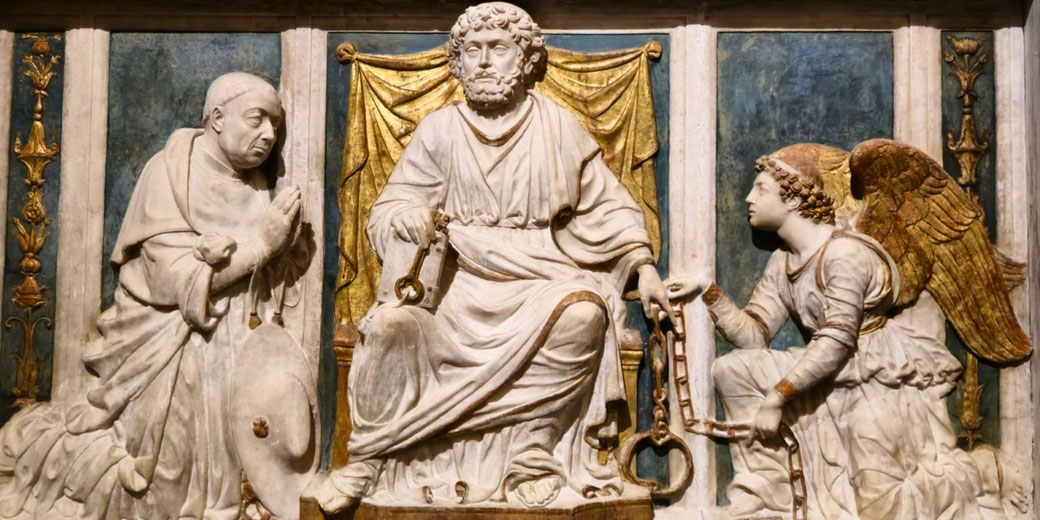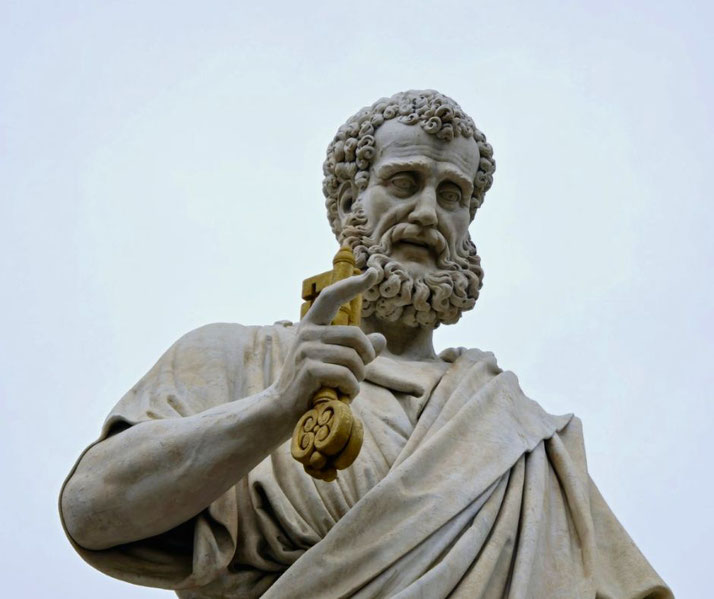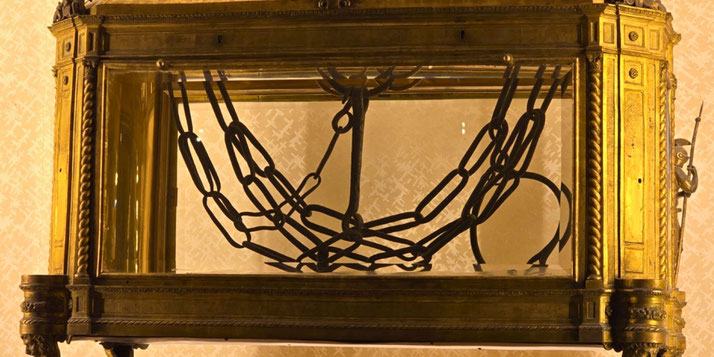Crucified upside down: The brutal nature of apostle Peter's death

In the heart of ancient Rome, under the tyrannical reign of Emperor Nero, the Apostle Peter is said to have met a gruesome death.
The fisherman from Galilee, who once walked beside Jesus, found himself crucified upside down, a final act of humility and devotion.
But what were the circumstances that led to this moment of sacrifice?
The early life and ministry of Peter
Born Simon bar Jonah in the village of Bethsaida on the Sea of Galilee, the man who would become Saint Peter lived the early years of his life in relative obscurity.
A fisherman by trade, Peter’s life was intricately tied to the waters of Galilee, where he toiled alongside his brother Andrew.
The simplicity of his existence, however, was destined to be transformed by a divine calling that would lead him to become one of the foremost figures in Christian history.
According to the Gospel accounts, Jesus approached Peter and Andrew as they were casting their nets into the Sea of Galilee.
With the profound proclamation, “Come, follow me, and I will make you fishers of men,” Jesus beckoned them into a life of discipleship.
Peter’s acceptance of this call marked the beginning of his transformation from a humble fisherman to a foundational apostle of Christianity.
As a disciple, Peter was a witness to the teachings, miracles, and divine mysteries of Jesus Christ.
He was often portrayed as a figure of impulsive faith and fervor, displaying both unwavering devotion and human fallibility.
One of the defining moments of his discipleship was his divine revelation at Caesarea Philippi, where he recognized and confessed Jesus as the Messiah, the Son of the living God.
This confession led to Jesus’ declaration of Peter as the ‘Rock’ upon which the Church would be built, signifying his pivotal role in the establishment of the Christian faith.
Peter's role in the early church
Following the Ascension of Jesus Christ, Peter emerged as a central figure and a guiding force in the early Church.
His leadership, characterized by unwavering faith and a deep sense of commitment, played a pivotal role in steering the Christian community through its formative years.
Peter’s presence was not just as a spiritual guide; he was a cornerstone, helping to shape the theological, organizational, and missionary dimensions of early Christian life.
One of the seminal moments of his leadership was his advocacy for the inclusion of Gentiles into the Christian fold, a decision that marked a significant turning point in Christian history.
The Council of Jerusalem, as documented in the Acts of the Apostles, highlighted Peter’s role in bridging divisions and fostering unity among Jewish and Gentile Christians, thereby shaping the universal nature of the Church.
As a missionary, Peter traversed regions, spreading the teachings of Jesus Christ and establishing Christian communities.
His journeys took him to places such as Antioch, where he served as a leader of the Christian community, and eventually to Rome, the heart of the Roman Empire.
In each place, Peter’s ministry focused on nurturing the faith of believers, addressing theological questions, and fortifying the organizational structure of the Christian communities.
His epistles, First and Second Peter, are testament to his theological reflections and pastoral concerns, offering guidance and encouragement to Christians facing persecution and challenges to their faith.

Why did Peter travel to Rome?
The culmination of Peter’s apostolic journeys was his arrival in Rome, the heart of imperial power and a city of immense cultural and political significance.
Tradition holds that Peter’s ministry in Rome was marked by his leadership of the Christian community, his confrontation with Simon Magus, and his unwavering proclamation of the Gospel in the face of persecution.
The city, a sprawling metropolis at the heart of the Roman Empire, was a melting pot of cultures, beliefs, and power dynamics.
The reign of Emperor Nero was a particularly dark chapter in the history of early Christianity.
Known for his extravagance, cruelty, and erratic behavior, Nero’s relationship with Christians was marked by suspicion and hostility.
The Great Fire of Rome in 64 AD, which devastated large parts of the city, became a turning point for Christians in the Empire.
Accused of starting the fire by Nero, Christians faced widespread persecution, subjected to arrests, tortures, and public executions.
Peter’s presence in Rome and his role as a leader of the Christian community placed him in a precarious position.
As the persecution intensified, he became a target for the imperial authorities, symbolizing the resilience and growth of the Christian faith.
Historical and religious traditions suggest that Peter, aware of the impending danger, considered leaving Rome to preserve his life and continue his ministry.
However, a vision of Christ, interpreted as a sign of his approaching martyrdom, compelled him to remain and face the consequences of his apostolic calling.
The martyrdom of Peter
Peter’s crucifixion was not just a reflection of the brutality of the times; it was imbued with deep symbolism and significance.
Tradition holds that Peter, deeming himself unworthy to die in the same manner as his Lord and Savior, Jesus Christ, requested to be crucified upside down.
This act of humility and reverence showcased Peter’s profound love for Christ and his understanding of the sacredness of the sacrifice he was about to make.

The site of Peter’s martyrdom is traditionally identified as the Vatican Hill in Rome, and it is believed that his remains were initially buried nearby, marking the beginning of a centuries-long veneration of the Apostle.
The Basilica of Saint Peter, a monumental edifice and a center of Christian pilgrimage, now stands over this site.
The Roman Catholic Church holds a special reverence for Peter, recognizing him as the first Bishop of Rome and, by extension, the first Pope.
This apostolic succession, traced back to Peter, is a cornerstone of the Catholic faith, symbolizing the continuity of spiritual authority and the unity of the Church.
The Basilica of Saint Peter in Vatican City stands as a monumental tribute to the Apostle, attracting millions of pilgrims and visitors each year, all drawn to the spiritual significance and historical resonance of the site.
How true is this story?
The life and death of the Apostle Peter, while revered in Christian tradition, have not been without historical controversies and debates.
Scholars and theologians alike have questioned the authenticity and reliability of the accounts detailing Peter’s presence and activities in Rome.
While ecclesiastical tradition firmly places Peter in Rome, where he met his martyrdom, some scholars have questioned the veracity of these narratives, citing a lack of contemporary evidence and discrepancies in ancient writings.
Another area of contention is the location of Peter’s burial. The Vatican Hill, where St. Peter’s Basilica now stands, is traditionally believed to be the resting place of the Apostle.
However, the discovery of ancient tombs and inscriptions has sparked debates about the accuracy of this claim, leading to ongoing archaeological investigations and scholarly discussions.
The question of whether the relics venerated as Peter’s remains are indeed authentic has been a subject of speculation, with varying opinions and interpretations presented over the years.
Finally, the role of Peter in the development of the Papacy and the early Christian Church has also been a focal point of historical inquiry.
The concept of apostolic succession, with Peter as the first Pope, is a foundational doctrine of the Roman Catholic Church.
Nonetheless, differing views exist regarding the nature of Peter’s leadership, the extent of his authority, and the implications of his primacy for the governance and structure of the Church.
These discussions have implications not only for understanding the historical Peter but also for the broader theological and ecclesiastical considerations of Christian tradition.
What do you need help with?
Download ready-to-use digital learning resources
Copyright © History Skills 2014-2025.
Contact via email
With the exception of links to external sites, some historical sources and extracts from specific publications, all content on this website is copyrighted by History Skills. This content may not be copied, republished or redistributed without written permission from the website creator. Please use the Contact page to obtain relevant permission.





